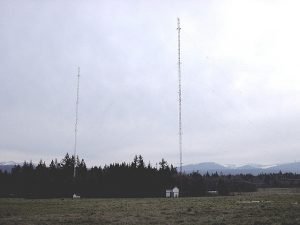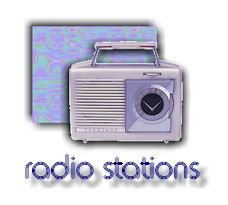
In our ongoing series on today’s AM radio, we’ve examined a number of factors working against the viability of this struggling sector of the broadcasting industry. Many changes, both in technology & how the public access information & entertainment have worked against radio in general, more so AM broadcasters. Yet another consideration is the high cost of real estate & ever-spreading expansion of our urban areas. AM transmission towers & their underground ‘radials’ which are a necessity for this mode of broadcasting a signal, require a significant amount of land – often farm land which at one time was outright owned, but now often leased. A number of AM stations have lost their lease as owners give in to the temptation to sell their valuable land at a premium price to land developers. This has also created problems keeping medium to high powered AM signals to penetrate the noise pollution created by all of our electronic devices. In this region, 1460 KARR lost it’s transmission site as developers moved in to create new housing on the land. This has also occurred to Lakewood’s 1480 KNTB & was also rumoured as a factor in the recent sale of 1180 KLAY. This, along with the higher costs of transmission equipment & increased maintenance, have put the costs of AM broadcasting much, much higher than FM which is a distinct disadvantage.

In spite of the many hurdles AM faces, the FCC has been either non-existent or slow to respond to the changes and many of their “solutions” are too little too late. With plenty of pressure from the powerful NAB, the FCC in recent years has touted it’s much publicized “AM Revitalization” in hopes of preventing AM broadcasters from going out of business. However, it’s this reporter’s contention that the FCC should have started it’s revitalization plan as far back as 1970 as the FM band went from being an afterthought complimenting & supplementing AM stations, to a full-blown successful evolution in the broadcasting landscape. The feds failed to realize that the superior audio & transmission of FM, would overtake AM in popularity & should have acted accordingly. BEFORE the proliferation & abuse of translators, BEFORE the corporate take-over of FM by well-funded Christian organizations, BEFORE LPFM, BEFORE the FM band became over-crowded & stuffed with signals, the FCC should have done as has occurred in many other countries including Canada to the north: allowing AM stations to shut down & “flip” to the FM band. I suggest this should have taken place beginning in the 70’s. While many urban areas were filling up blank frequency assignments with new stations, in most medium & small markets, a number of open frequencies were – and still are – available. The pecking order applying for these open channels should not have gone to the most powerful, corporate broadcasters, in fact quite the opposite. The first AM’s that should have been offered a flip to FM were the daytimers. These stations should have been given the option to either shut down the AM & move to FM, OR keep the AM’s on-air as simulcasts until local sunset shutdown, continuing on up to 24/7 via their new FM signals. Instead, the FCC gave in & allowed many of these stations restricted, highly directional & lower powered night signals adding noise, cacaphony during darkness when AM signals travel great distances via the ionosphere. An even more ill- thought decision was allowing daytimers “flea-powered” (under 100 watts) night allowances which serve nobody. The 2nd group of AM’s that should have had a crack at FM licenses would be the “graveyard” Class IV AM’s stuck on 1230. 1240, 1340, 1450 & 1490 with 1 kW/day & much less at night. The result may have been more success for these small station owners, better local coverage, a much less cluttered AM band at night & more diversity on the FM dial. But where to find the space to accommodate these? The ill-thought out NCE portion of FM: 88-92 mHz was initially designed for lower powered non-commercial broadcasters which was the case in FM’s early days right up to 1980. However, by that time many had adopted high power FM signals & thus, no longer required special protection. The FCC should have reduced the “low-power” FM channel assignments at that time, reducing these to perhaps 88-89 mHz. The remainder of 89-92 mHz could have been re-assigned to both commercial & non-commercial broadcasters offering up more space to accommodate AM flips.

In a related issue, the FCC has repeatedly over the years rejected demands & proposals to expand the FM band down to 76 mHz as is the case in many other parts of the world. With TV channels 5 & 6 having very few occupants due to the TV channel repacking, the time is ripe to expand the FM dial & most FM radios manufactured in Asia have had this capability, often requiring nothing more than an internal switch to make the additional 76-88 mHz frequencies receivable. Even my vintage 1990’s Magnum Dynalab Etude FT-101 FM monitor/tuner was easily converted & now tunes down to 76 mHz. Likewise my late-90’s Sony portable, sometimes seen here in photos. I also quickly converted a 1990 Toyota truck receiver to tune down to 76 mHz. With less & less consumer HD home receivers now sold, there is still a market for analog FM tuners & there would be no additional costs to manufacturers making this expansion in their sets. Again, offering first chance for filing windows, would be the smallest & most low powered of AM broadcasters for this new spectrum before allowing the major corporations to gobble these up for their AM facilities. A surprising amount of America’s AM stations could be accommodated on the newly expanded FM dial. These could be offered a 5-year timeline to permanently shut down their AM facilities for good, or at the least, reduced to sunrise-sunset simulcast on AM. However, the commission refuses to entertain this idea.

The recent allowance by the FCC for AM operators to acquire low powered FM translators demonstrated a too-little-too-late mode of thought by the commission and should have been acted upon 40-45 years previous. This is a solution for some, but in other communities, terrain and tall buildings have done little to provide a workable alternative for AM’s hoping to acquire new listeners via the FM dial. In urban centers, an over-saturated, over- cluttered FM dial has provided little relief. It is in the largest of urban environments that interference & poor coverage is hampering AM broadcasters trying to reach all potential listeners in it’s primary contours. Broadcasters and the public are left with “band-aid” solutions to technical issues & development of the FM band that should have been dealt with a long time ago. In part 2 on “Revitalization” we’ll examine HD & the recent proposal to reduce the night-time coverage of Class A AM broadcasters who once operated on ‘clear channels’.


Some comments may be held for moderation. (New users)